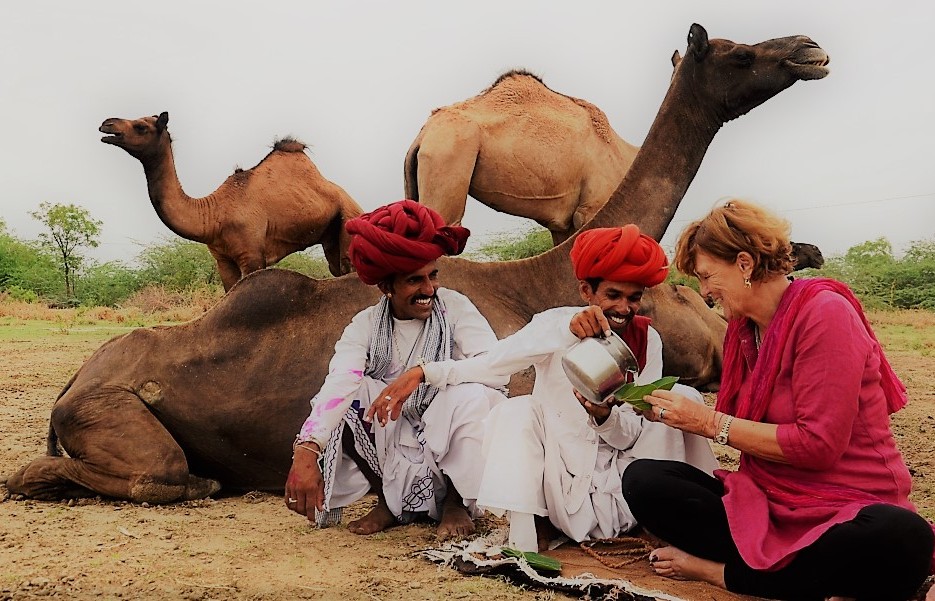The ingenuous, delicious breakfasts of the Raika nomads of Rajasthan
It is a chilly December morning in 2016 and I am sitting on a charpoy, surrounded by a sea of sheep. The spot where I sit is a tiny blip of stability in an ocean of woolly waves, just south of the NH 27 that links Udaipur with Chittorgarh in Southern Rajasthan. On my lap, I cradle a shiny steel plate which is stacked with just two items: a steaming sogra made from bajra, and a big white blob of sheep butter that is melting, spreading, dissipating on the sogra, soaking it in utterly butterly deliciousness.
Immersed in a cacophonous symphony of ewes and lambs communicating with each other, I am tearing off warm and creamy pieces of this delicious comfort food. Next to me, on the ground, my host Hanzabai has carved out a small spot for herself to cook amidst her sheep. She crouches in front of a portable chulha, preparing another sogra, expertly pulling it into shape and then plopping it onto the tawa for it to cook. “Ek aur?” she asks rather rhetorically, as if I – or anybody else with a love for food – could resist. She generously tops the sogra with another splotch of the white, slightly sour butter from a small metal bowl.
I have worked with the Raika, a traditional nomadic pastoralist community in Rajasthan, for 30 years now; and I am still in awe about the way these shepherds and camel breeders manage to produce food, totally in tune with nature, without fossil fuels or any use of chemicals, showing us the way how this can be done.

The butter that I eat has been made from the milk that the sheep had shared with us the previous evening. It had soured overnight in a big earthen matka; and Hanzabai had solidified it into creamy chunks by rhythmically pulling back and forth the strings of a wooden churn.
Quite an early morning workout, I thought, as I watched. Churn, matka, and chulha are among the essential pieces of equipment that the Raika shepherds take with them on their migration, which lasts about nine months, depending on the extent of the monsoon. Hanzabai’s home village is in Godwar, a sliver of an area in central Rajasthan where the Aravalli Hills transition into the Thar Desert. But her family stays here only during the rainy season. When the rains stop, they move with their herds to the harvested fields in Southern Rajasthan and Madhya Pradesh to make use of the crop waste that remains on the fields, and turn this into much needed organic manure.
The farmers – with whom the Raika often have long-standing relations that go back generations – pay them in cash and kind, such as the grain from which my sogra was made.
It is a wonderful example of a circular economy, in which crop waste is utilised and nutrients are returned to the soil, in which food is produced without chemicals and fossil fuels, in which crops and livestock are integrated based on nature’s underlying principles.
Such economic and culinary ingenuity deserves all our respect and support. But unfortunately, this way of life is often deemed backward and primitive by the government and by elite, urban Indians, despite it actually showing us the path to true sustainability.

Sheep migration is a family affair, with women having the role of cooking, looking after lambs, carrying water, and processing the milk. Meanwhile, men herd the flock and guard it against thieves at night. A number of families form a herding conglomerate that is known as dera. This dera includes camels to transport household equipment, goats to act as nannies and wet nurses for orphaned lambs, and sometimes donkeys and dogs.
In contrast, camel herding is a job only for men. Here too, the herders form small groups that move and camp together, share chores such as milking, the supervision of breeding, taking care of newborn calves, and taking the milk to the dairy. But cooking often occurs on the wayside, with hot meals provided only by the farmers of the field they stay on overnight, in similar appreciation of the organic manure the camel-herding Raika provide.
But even in the absence of a considerate landowner, the herders have the most nutritious food at hand that is always available on demand: camel milk. If need be, they can keep going on this for days on end.
The camel milk that Raika herders eat for breakfast is freshly obtained from a cooperative camel, and served on the leaf of the aak tree (Calotropis procera) that is folded into a biodegradable cup. It is delicious, although its taste – that is very similar to cow milk – changes, depending on the diet of the camels. Some trees and herbs, such as bordi (Zizyphus nummularia) and the Indian Globe Thistle (Echinops echinatus) sweeten the milk, while others, for instance neem, may give it a bitter tinge or a salty hint. According to Raika traditional knowledge, camels nosh on upto 36 ayurvedic plants and from the taste of the milk, a herder can easily detect which botanicals the camel has foraged on. This diverse natural diet of camels renders their milk to be medicinal as well, proving therapeutic for people with diabetes, liver problems, and asthma among other illnesses.
While fresh camel milk has a soothing and entrancing effect – apparently somewhat reminiscent of opium – camel milk chai is energising and invigorating.
It is this that keeps camel herders going during their hard and strenuous work of walking around with camels all day. The Raika brew it over the campfire with tea leaves and sugar provided by the farmer, making it with minimum or no water. On special occasions when rice is available, the camel herders’ breakfast is upgraded to kheer made with camel milk.
Even as this exhausts the culinary spectrum that the camel nomads have to offer, camel milk lends itself to a range of dairy products. You can sample these at the Kumbhalgarh Camel Dairy, which I have set up with a partner to create some much needed income for the Raika camel breeders. Visit for a taste of piquant cream cheeses, and milder camel feta made without any artificial ingredients or preservatives. And if you would like something more elaborate, you can even book a five-course meal based on camel dairy products that seeks to transform camel milk into a unique taste experience for urban palates.

Ilse Kohler-Rollefson is a German veterinary scientist who has spent the last thirty years among pastoralist cultures, especially the Raika camel nomads of Rajasthan and believes their hereditary practices show us the way towards ethical livestock keeping in the future. She is author of Camel Karma, Hoofprints on the Land, and co-founder of Camel Charisma, a social enterprise that promotes ecological products from living camels. You can find out more about her at ilse-koehler-rollefson.com

